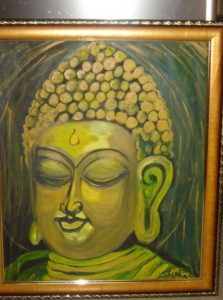City of Varanasi: Breathing and Living Art and Architecture in Northern India
Scenic angles of Varanasi, an ancient city in Modern India :
Vishwanath Temple: Situated in heart of Banaras Hindu University (BHU) Campus. Lord Shiva’s Temple. My Alma Mater! A “Sacred” hangout for BHU Students before and after exams and results. Locals also find peace, in this scenic sanctuary, perfect for meditations, far away from city hustle and bustle.
City Temples and Religious Places: Varanasi is the city of temples. Its ancient, sacred walls, also serve as huge canvas, for street art for numerous artists.
City Wall Art/Murals : Wall murals of God and Goddess by anonymous painters, one such mural Lord Shiva and Goddess Saraswati in this narrow city by lane with locals busy in their routine work. Such vibrant colors and depictions of artists, make sacred city more alive and full of religious sentiments and traditions.
City Wall Vibrant Murals: Wall painting of Gautam Buddha by anonymous painter tells story, that Lord Buddha was also part of this rich culture, of the city of Varanasi/Kashi/Banaras, once upon a time.
Sarnath Stupa: One of the places where Buddha and his disciples resided and preached Buddhism. Lord Buddha gave his first sermon after enlightenment. Ashoka’s pillar is also one of the reason for pilgrimage to this holy land. Lord Buddha set the Wheel of Dharma here and since then, for 1500 years Sarnath flourished as a Centre for Buddhist Learning. Current times also hold importance, of this peaceful shrine and followers of Buddhism and locals and historians also visit Sarnath and adjacent Historic Museum to relive that era through its remains.
City of Ghats: Varanasi as seen from the banks of River Ganges, joined palaces, temples and ancient buildings are unique architecture of Varanasi known as “Ghat”. One can listen chants and ringing of bells, prayers in early morning and late evenings, especially. There are nearly 87 Ghats, all connected to each other. One can walk through or reach to next one through row boating, by local boat rowing people called “Mallahs”. One can hire boats by reaching to the bank of river, through steps/ staircases, as seen in picture.
Tea Stalls on Every Nook and Corners: Local gossips, politics and discussions on range of literary and artistic topics come alive with a sip of tea, from earthen pots known as “Kullahds”. Varanasi local’s “staple drink” of all seasons. Local tea (chai) stalls are inherent jewels in Varanasi fabric. 💎
Architecture on Bank of River Ganges: Palaces and buildings are still inhabited by descendants of ancient courtiers and Royals of Kashi.
River Ganges(Ganga) Prayers/Arti: A Scene from famous Ganga prayer (Arti) which is religiously done every evening in the same form with incenses. drums, bells, trumpets and earthen lights.
Goddess Ganga Arti: Daily Ganga Arti at dusk. Starts after sunset and is carried for around 45 minutes, by priests circulating earthen lamps in rhythmic patterns, chants of bhajans, mantras and holy syllables to pay respect to River Ganges and seek holy blessing. This scene especially becomes mesmerizing on the eve of “Ganga Dussehra” when Goddess Ganga was supposed to descended on earth from Heaven, through Lord Shiva’s dense head knot.
Last Rites and Moksha: People who breath their last here in Varanasi, are supposed to be set free, forever from cycle of “life and death”. They seek “Moksha”, the “Nirvana”. Last rites, traditional last journey and related last ceremonies of a local Hindu individual ends here on sacred Ganges banks, on “Manikarnika Ghat”, in anticipation of Nirvana, a state of perfect happiness and end of all sufferings!
